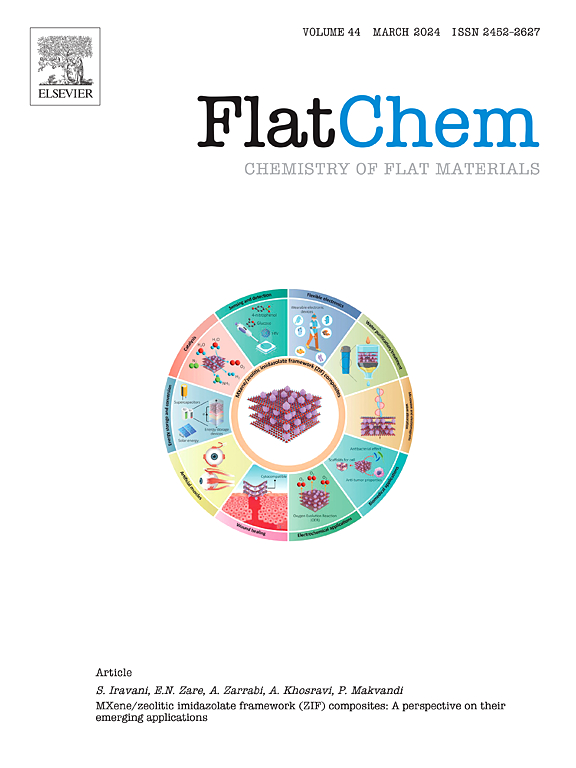高性能超级电容器的cu /CoS异质结电沉积增强氧化还原动力学
IF 6.2
3区 材料科学
Q2 CHEMISTRY, PHYSICAL
引用次数: 0
摘要
为了进一步提高过渡金属硫化物电极材料的电化学性能,构建异质结是一种有效的策略。在这种情况下,通过简单的两步循环伏安法(CV)电沉积,合成了具有独特分层花状形貌的cu /CoS异质结。新获得的花状结构显着扩大了电极材料和电解质之间的接触面积,同时也增加了材料的活性位点。此外,还证明了cu和CoS之间存在明显的协同相互作用。更重要的是,异质结之间内置的内部电场可以有效地分离电子和空穴,从而达到提高电导率的目的,这无疑也有利于提高氧化还原动力学。这些优点的结合最终产生了出色的电容特性,达到0.79 mWh cm - 2(在2 mA cm - 2下为7.09 F cm - 2)和卓越的循环寿命(在8500次循环中保持68.17%)。值得注意的是,相应的非对称超级电容器(ASC)装置可以在5.91 mW cm - 2的功率密度下实现高达1.04 mW h cm - 2的能量密度,并且在8500次循环时保持71.85%的容量,超过了大多数其他相关报道。总之,所开发的异质结作为高性能储能电极材料具有巨大的潜力,为推进储能领域的发展提供了一条实用有效的途径。本文章由计算机程序翻译,如有差异,请以英文原文为准。

CuS/CoS heterojunction with enhanced redox kinetics via electrodeposition for high-performance supercapacitors
For the purpose of further boosting the electrochemical properties of transition metal sulfide electrode materials, constructing heterojunction is an effective strategy. Under this circumstance, CuS/CoS heterojunction with unique hierarchical flower-like morphology is synthesized via a simple two-step Cyclic Voltammetry (CV) electrodeposition. The newly acquired flower-like structure significantly enlarges the contact area between the electrode material and electrolyte while also increasing the material's active sites. Additionally, a distinct synergistic interaction between CuS and CoS is demonstrated. More importantly, the build-in internal electric field among heterojunction can effectively separate the electrons and holes, so as to achieve improved conductivity, which is also undoubtedly beneficial to enhance the redox kinetics. The combination of these advantages ultimately yields outstanding capacitance characteristics, achieving 0.79 mWh cm−2 (7.09 F cm−2 at 2 mA cm−2) and remarkable cycle life (68.17 % retention over 8500 cycles). Notably, the corresponding assembled asymmetric supercapacitor (ASC) device can achieve up to an energy density of 1.04 mW h cm−2 at a power density of 5.91 mW cm−2 and 71.85 % capacity retention at 8500 cycles, surpassing most other relevant reports. All in all, the developed heterojunction presents significant potential as high-performance energy storage electrode material and provides a practical and effective pathway for advancing the field of energy storage.
求助全文
通过发布文献求助,成功后即可免费获取论文全文。
去求助
来源期刊

FlatChem
Multiple-
CiteScore
8.40
自引率
6.50%
发文量
104
审稿时长
26 days
期刊介绍:
FlatChem - Chemistry of Flat Materials, a new voice in the community, publishes original and significant, cutting-edge research related to the chemistry of graphene and related 2D & layered materials. The overall aim of the journal is to combine the chemistry and applications of these materials, where the submission of communications, full papers, and concepts should contain chemistry in a materials context, which can be both experimental and/or theoretical. In addition to original research articles, FlatChem also offers reviews, minireviews, highlights and perspectives on the future of this research area with the scientific leaders in fields related to Flat Materials. Topics of interest include, but are not limited to, the following: -Design, synthesis, applications and investigation of graphene, graphene related materials and other 2D & layered materials (for example Silicene, Germanene, Phosphorene, MXenes, Boron nitride, Transition metal dichalcogenides) -Characterization of these materials using all forms of spectroscopy and microscopy techniques -Chemical modification or functionalization and dispersion of these materials, as well as interactions with other materials -Exploring the surface chemistry of these materials for applications in: Sensors or detectors in electrochemical/Lab on a Chip devices, Composite materials, Membranes, Environment technology, Catalysis for energy storage and conversion (for example fuel cells, supercapacitors, batteries, hydrogen storage), Biomedical technology (drug delivery, biosensing, bioimaging)
 求助内容:
求助内容: 应助结果提醒方式:
应助结果提醒方式:


